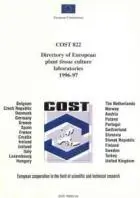
Rationeller energieensatz im interregional verkehr

3rd Ecopapertech Conference - Economy and ecology in Papermaking Technology, June 4-8, 2001 Helsinki, Finland: Proceedings

Measurment of Atmospheric Acidity

Fracture Mechanics in Wood Materials

Directory of European Plant Tissue Culture Laboratories 1996-97

Second PhD Students Retreat - Brussels, 8-10 November 2006

Biotechnology of Soil Monitoring, Conversation and Remediation - Report of Activities 1997-1998

Proceedings of the First International Symposium on Cryopreservation in Horticultural Species / Acta Horticulturae Number 908
- Author(s): B. Panis & P. Lynch (Eds)
- Publisher(s): ISHS
- http://www.actahort.org/books/908/index.htm
- ISBN/ISSN: 978-90-6605-470-7
For many horticultural species such as seedless plant species, species that produce recalcitrant seed as well as plant species that are propagated vegetatively to preserve the unique genomic constitution of cultivars (such as fruit and several timber and ornamental trees), cryopreservation is the only valuable solution for the safe long term storage. Moreover, besides its use for the conservation of genetic resources, cryopreservation proved to be extremely useful for the storage of plant tissues with specific characteristics, such as medicinal- and alkaloid-producing cell lines, hairy root cultures, genetically transformed and transformation-competent culture lines.
This issue of Acta Horticulturae contains a selection of the contributions made at the “first International Symposium on Cryopreservation in Horticultural Species” that was held in Leuven, Belgium from 5 to 8 April, 2009. This event was a co-organization of the COST Action 871, CRYOPLANET of the European Science Foundation and ISHS (International Society for Horticultural Science).

Emissions and Fuel Consumption from Heavy Duty Vehicles: COST 356 - Final Report
- Pages: 139 pages
- Author(s): P. J. Strum, S. Hausberger
- Publisher(s): Graz University of Technology
- ISBN/ISSN: 978-3-902465-48-1
The primary objective of the Action was to develop an improved methodology for estimating pollutant emissions and fuel consumption from commercial road transport operated with Heavy Duty Vehicles (HDV’s) in Europe. The methods should make it possible to estimate the emissions from single vehicles, as well as, from vehicle fleets. The activities were concentrated on improving the amount and quality of basic data on emissions and transport activity, as well as, on validating and enhancing existing models.
